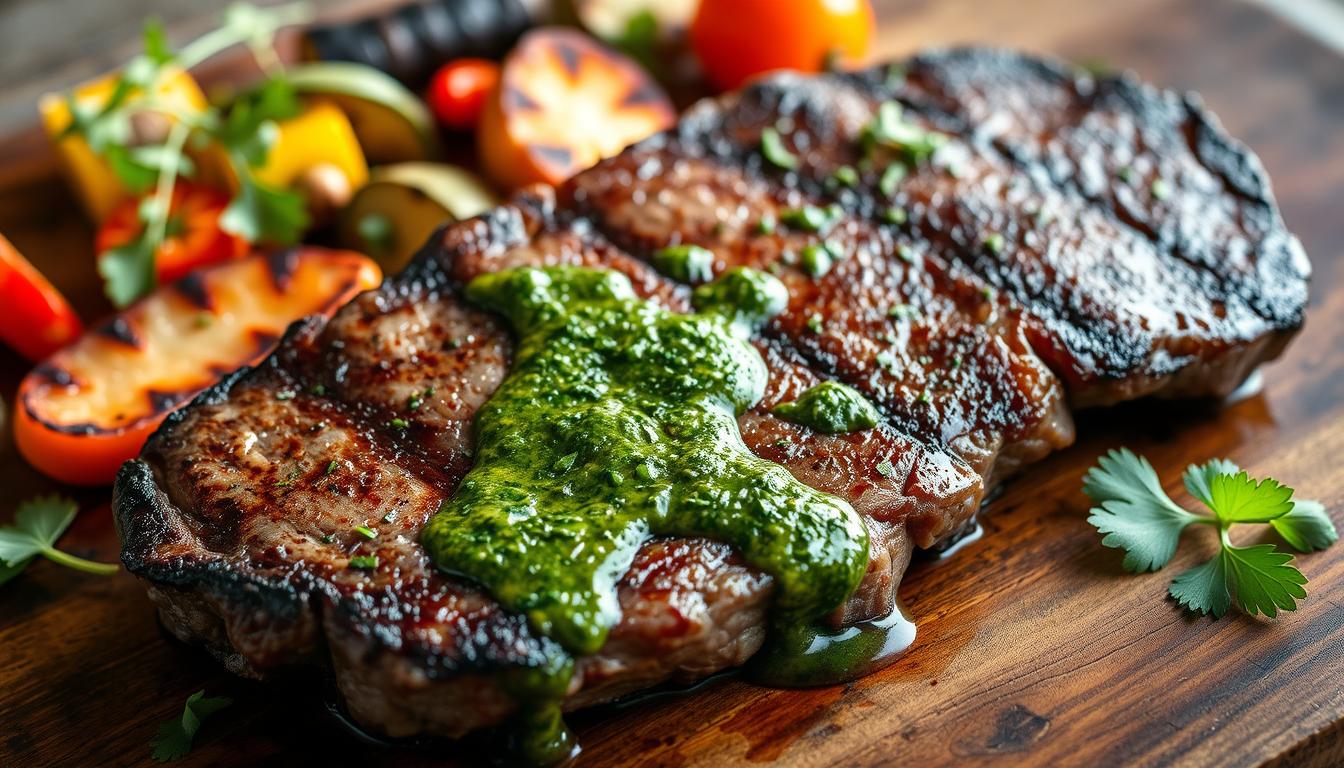Let’s dive into the flavors of Argentinian Steak with Chimichurri. It’s a key part of South American barbecue. This dish mixes tender, grilled beef with a fresh herb sauce.
Argentinian Steak with Chimichurri is loved worldwide. It comes from the pampas, where gauchos cooked over open fires. We’ll look at its cultural importance and delicious taste.
Ready to explore South American barbecue? We’ll show you how to pick the best cut, grill it right, and make real chimichurri. Get ready to enjoy a taste of Argentina at home!
Understanding the Heritage of Argentine Beef Culture
Argentine beef culture is deeply rooted in history. It has shaped the nation’s identity and culinary traditions. This heritage has made Argentina famous for its exceptional steaks and the beloved asado.
The Gaucho Tradition and Cattle Ranching
Gauchos, Argentina’s legendary cowboys, were key in the beef industry’s growth. Their gaucho cuisine, based on open-fire cooking, started modern asado practices. These skilled horsemen herded cattle across vast grasslands, ensuring top-quality beef.
The Pampas: Home of Premium Beef
The Pampas, Argentina’s fertile plains, are at the heart of the cattle industry. This region’s climate and lush grasslands produce world-class beef. The pampas tradition of cattle raising has been perfected over generations, resulting in meat known for its exceptional flavor and tenderness.
Evolution of Asado Culture
Asado has grown from a simple gaucho meal to a cherished social event. Today, it’s more than cooking meat; it’s a celebration of Argentine culture and community. The rituals and techniques of asado have been refined over time, blending traditional methods with modern culinary innovations.
| Era | Asado Characteristics | Cultural Significance |
|---|---|---|
| Early Gaucho | Simple, open-fire cooking | Sustenance for cattle drives |
| 19th Century | Introduction of grilling techniques | Social gatherings among ranchers |
| Modern Day | Refined methods, diverse cuts | National pastime, family tradition |
What Makes Argentinian Steak with Chimichurri Special
Argentinian steak with chimichurri sauce is a dish loved by many. It’s special because of the mix of top-notch beef and a fresh herb sauce.
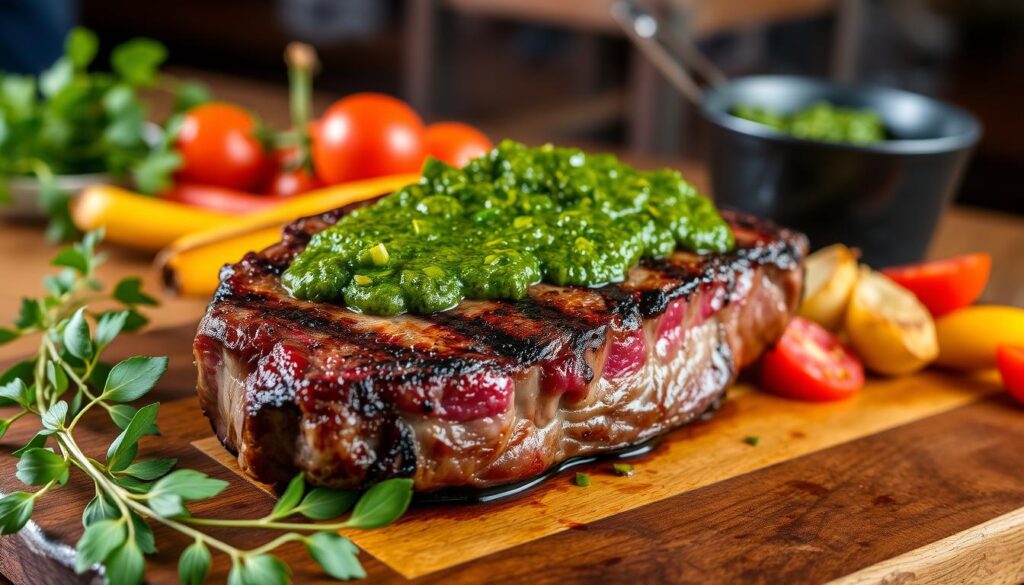
The beef in this dish comes from Argentina’s Pampas grasslands. This area gives the meat a unique taste and softness. You can pick a juicy ribeye or a lean tenderloin, and it will always taste great.
The chimichurri sauce makes the steak even better. It’s a mix of herbs, garlic, and vinegar. This blend adds a zesty flavor that goes well with the beef.
| Component | Contribution to Dish |
|---|---|
| Argentine Beef | Rich flavor, tender texture |
| Chimichurri Sauce | Bright, herbaceous notes |
| Grilling Method | Smoky char, perfect crust |
How the steak is grilled is key. Argentinian chefs make sure the outside is charred right. At the same time, they keep the inside juicy, no matter the cut.
This mix of great beef, tasty chimichurri, and grilling skill makes the dish stand out. It’s why Argentinian steak with chimichurri is loved everywhere.
Essential Ingredients for Authentic Preparation
To make the perfect Argentinian steak with chimichurri sauce, pick your ingredients carefully. We’ll show you how to choose the best parts for this famous dish.
Selecting the Perfect Cut of Beef
For a real taste, choose prime cuts like beef tenderloin or grilled ribeye. These cuts have great flavor and are tender. Look for meat that’s well-marbled and has a deep red color.
Fresh Herbs and Spices for Chimichurri
For a lively chimichurri sauce, use fresh ingredients. Parsley, oregano, and garlic are the base. Add high-quality olive oil and red wine vinegar for flavor.
Additional Seasonings and Components
To make your Argentinian steak even better, add these extras:
- Sea salt and freshly ground black pepper
- Red pepper flakes for a spicy kick
- Lemon juice for brightness
| Ingredient | Purpose | Quantity (for 4 servings) |
|---|---|---|
| Beef tenderloin or grilled ribeye | Main protein | 4 steaks (8 oz each) |
| Fresh parsley | Chimichurri base | 1 cup, chopped |
| Fresh oregano | Chimichurri flavor | 2 tablespoons, chopped |
| Garlic | Chimichurri aroma | 4 cloves, minced |
| Olive oil | Chimichurri texture | 1/2 cup |
| Red wine vinegar | Chimichurri acidity | 1/4 cup |
Traditional Grilling Methods: The Parilla Technique
The Argentine parilla is the heart of South American barbecue. It has been perfected over generations. This technique creates mouthwatering asados celebrated worldwide. Let’s explore the key elements of this iconic technique.
Fire Management and Temperature Control
Mastering fire is key in parilla grilling. We start with hardwood coals. We arrange them to create different heat zones.
This allows for precise temperature control. It’s essential for cooking various cuts of meat to perfection.
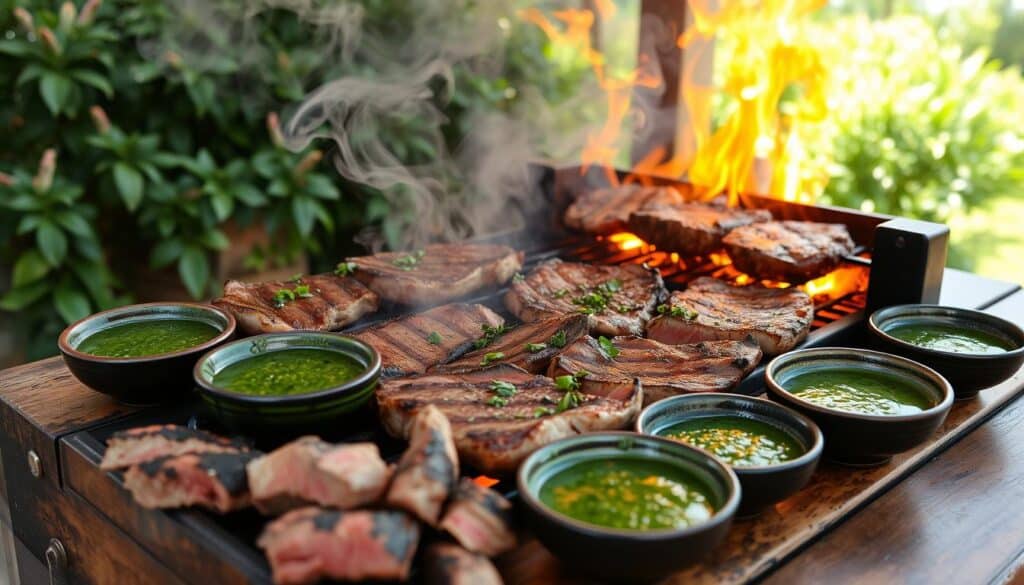
Proper Grilling Times and Techniques
Timing is everything in asado. Thick cuts are seared at high heat. Then, they’re moved to cooler zones to finish cooking.
Thinner cuts stay over intense heat for a shorter time. This method ensures juicy interiors and crisp exteriors.
Traditional Grilling Equipment
The right tools make all the difference in South American barbecue. Here’s what you’ll need for an authentic parilla experience:
| Equipment | Purpose |
|---|---|
| Parilla Grill | V-shaped grates for fat drainage |
| Asador Cross | For whole animal roasting |
| Chimney Starter | Quick coal ignition |
| Long-handled Tongs | Safe meat handling |
With these techniques and tools, you’re ready to bring the flavors of Argentine asado to your own backyard. Remember, patience and practice are key to mastering the art of parilla grilling.
Crafting the Perfect Chimichurri Sauce
Chimichurri sauce is the heart of South American barbecue. It makes any grilled meat, like Argentinian steak, taste amazing. We’ll show you how to make a real chimichurri that will take you to the Pampas.
The secret to great chimichurri is in its fresh ingredients. You’ll need:
- Parsley
- Oregano
- Garlic
- Red wine vinegar
- Olive oil
- Red pepper flakes
Chop the herbs finely and mince the garlic. Then, mix everything in a bowl. The vinegar gives it a tangy taste, and olive oil holds it all together. Let it sit for at least an hour before you serve it.
| Ingredient | Amount | Purpose |
|---|---|---|
| Parsley | 1 cup | Base flavor |
| Oregano | 1/4 cup | Aromatic herb |
| Garlic | 4 cloves | Pungent kick |
| Red wine vinegar | 1/4 cup | Acidity |
| Olive oil | 3/4 cup | Binder |
| Red pepper flakes | 1 tsp | Heat |
Chimichurri should be a bit loose. Don’t blend it too much or you’ll lose its special texture. Pour it over your grilled meats for a true South American barbecue taste.
Step-by-Step Grilling Instructions
Learning to grill Argentinian steak needs focus and care. We’ll show you how to prepare and cook the best beef on an Argentine parilla.
Meat Preparation and Seasoning
Choose a top-notch cut like grilled ribeye or beef tenderloin. Dry the meat with paper towels. Then, sprinkle coarse salt all over, rubbing it in well.
Let the steak warm up at room temperature for 30 minutes before grilling.
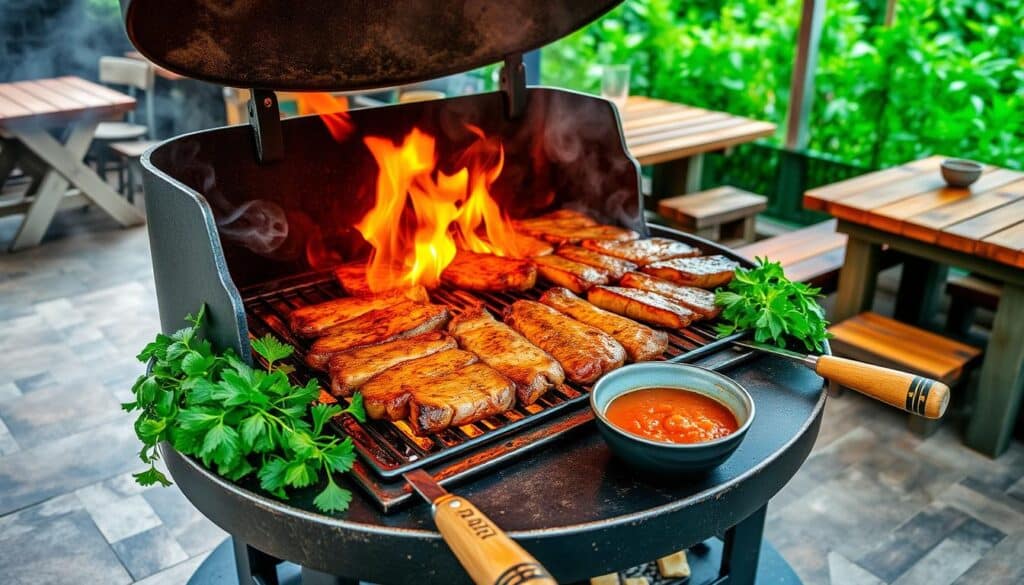
Grilling Process and Timing
Heat your Argentine parilla to high. Put the steak on and cook for 3-4 minutes on each side for medium-rare. Flip it only once with tongs.
To get a crosshatch pattern, turn the steak 45 degrees halfway through cooking on each side.
Resting and Serving Guidelines
Take the steak off the grill and let it rest on a cutting board for 5-10 minutes. This lets the juices spread evenly in the meat.
Slice it against the grain and serve right away with chimichurri sauce on the side.
- For rare: Internal temperature of 125°F (52°C)
- For medium-rare: Internal temperature of 135°F (57°C)
- For medium: Internal temperature of 145°F (63°C)
The secret to a great Argentinian steak is the quality of the meat and how simple it’s prepared. Let the natural flavors stand out!
Pairing Suggestions and Side Dishes
No Argentine asado is complete without the perfect accompaniments. We’ll guide you through traditional side dishes and drinks that elevate your gaucho cuisine experience.
Traditional Argentine Accompaniments
The parrillada completa, or full grill, is more than just meat. Authentic side dishes add depth and balance to the meal. Try these classic options:
- Provoleta: Grilled provolone cheese with herbs
- Ensalada criolla: Fresh tomato and onion salad
- Papas al plomo: Foil-wrapped potatoes cooked in embers
- Choclo: Grilled corn on the cob
Wine and Beverage Pairings
The right drink can enhance your asado experience. Argentina’s wine regions offer excellent pairings:
| Wine | Region | Pairing |
|---|---|---|
| Malbec | Mendoza | Ribeye steak |
| Torrontés | Salta | Grilled seafood |
| Bonarda | San Juan | Chorizo sausage |
For non-alcoholic options, try mate, Argentina’s national drink. This caffeine-rich beverage is perfect for sipping between bites, much like how Peruvians enjoy leche de tigre with ceviche.
Common Mistakes to Avoid
Cooking Argentinian Steak with Chimichurri can be tricky for newcomers. We’ve identified key pitfalls to help you achieve the perfect grilled ribeye. Let’s explore these common errors and learn how to sidestep them.
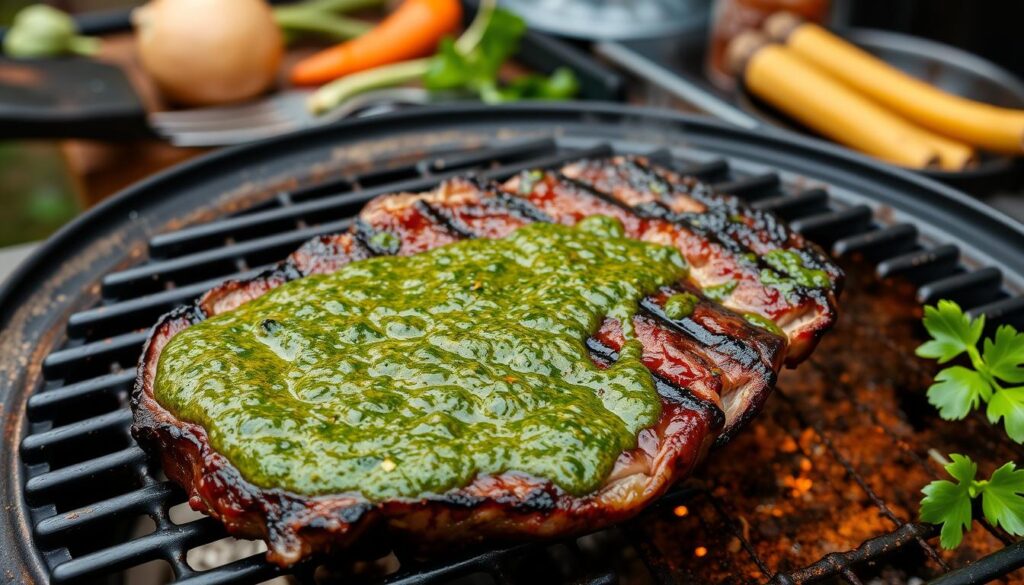
Overcooking is a frequent mistake. The ideal Argentinian steak should be medium-rare, preserving its juiciness. Use a meat thermometer to ensure accuracy. For a perfect medium-rare, aim for an internal temperature of 135°F (57°C).
Seasoning errors can ruin your steak. Many overcomplicate it, forgetting that salt and pepper are often enough. Let the beef’s natural flavors shine through. Apply seasoning generously just before grilling.
Chimichurri sauce preparation requires attention. Avoid using a food processor, which can turn herbs into mush. Instead, chop ingredients by hand for the best texture and flavor release.
| Common Mistake | Solution |
|---|---|
| Overcooking | Use a meat thermometer, aim for 135°F (57°C) internal temperature |
| Over-seasoning | Stick to salt and pepper, apply just before grilling |
| Blending chimichurri | Chop ingredients by hand for ideal texture |
| Not resting the meat | Let steak rest for 5-10 minutes before cutting |
Remember, patience is key. Let your grilled ribeye rest for 5-10 minutes before slicing. This allows juices to redistribute, ensuring a moist and flavorful Argentinian steak with chimichurri sauce.
Regional Variations and Modern Interpretations
Argentina’s different areas bring their own twist to the classic steak with chimichurri. The pampas tradition shapes each province’s take on this South American barbecue favorite.
Provincial Differences in Preparation
In the north, chimichurri is spicier. The south likes it milder. Coastal places add seafood to their asado spreads.
Grilling methods also vary. Some areas prefer slow-cooking over quick grilling.
| Region | Chimichurri Style | Grilling Technique |
|---|---|---|
| Northern Argentina | Spicy, red pepper-heavy | High-heat, quick sear |
| Patagonia | Herb-forward, mild | Slow-roast over open flame |
| Buenos Aires | Balanced, classic recipe | Traditional parilla grilling |
Contemporary Adaptations
Modern chefs are making the Argentine steak experience new. They add exotic ingredients like lemongrass or ginger to chimichurri. Others try different cuts or even vegetarian options with grilled portobello mushrooms.
Fusion restaurants mix South American barbecue with global cuisines. They create unique dishes that respect tradition but also innovate. These new takes keep Argentinian steak with chimichurri exciting and fresh.
Tips for Hosting an Authentic Asado
Hosting an authentic asado is a great way to experience gaucho cuisine. We’ll guide you through planning, preparation, and cultural traditions. This will help you create a memorable Argentine barbecue experience.
Planning and Preparation
To host a successful asado, start by inviting friends and family. Plan your menu, focusing on a parrillada completa. This includes various cuts of beef, sausages, and offal.
Don’t forget to prepare chimichurri sauce and side dishes. Set up your grill area with proper ventilation. Gather necessary tools like tongs and a meat thermometer.
Cultural Etiquette and Traditions
Asado is more than just a meal; it’s a social event. The asador (grill master) is in charge of the meat. Guests contribute side dishes or drinks.
Patience is key – cooking can take several hours. Serve meat as it’s ready, starting with offal cuts like oxtail. Then move to sausages and steaks. Wine, like Malbec, is a traditional accompaniment.
| Asado Element | Description |
|---|---|
| Meat Selection | Beef cuts, sausages, offal |
| Cooking Method | Slow grilling over wood or charcoal |
| Essential Condiment | Chimichurri sauce |
| Beverage Pairing | Argentine Malbec wine |
By following these tips, you’ll create an authentic asado experience. It honors the rich traditions of Argentine cuisine. Remember, the key to a successful asado lies in good company, quality ingredients, and a relaxed atmosphere.
Conclusion
Argentinian Steak with Chimichurri is a true gem of South American barbecue. It captures the heart of gaucho cuisine. This dish blends rich history with mouthwatering flavors.
From the vast Pampas to your dinner table, it brings a taste of Argentina’s culinary heritage. We’ve explored the art of selecting prime cuts and mastering the parilla technique.
We’ve also crafted the perfect chimichurri sauce. These elements come together to create a meal that’s more than just food. It’s an experience.
The sizzle of the grill and the aroma of fresh herbs transport you to the ranches of South America. By embracing the traditions behind Argentinian Steak with Chimichurri, we connect with a culture.
This culture values quality, simplicity, and shared meals. Whether you’re hosting an asado or simply grilling for family, this dish offers a chance to savor one of the world’s great culinary traditions. So fire up the grill, gather your loved ones, and enjoy the robust flavors of this South American classic.

